Report on Growth and Exit Strategies, Business Plan for ABC Company
VerifiedAdded on 2023/01/04
|14
|4395
|49
Report
AI Summary
This report provides a detailed analysis of growth and exit strategies for ABC, a small business. It begins by assessing potential funding sources, including bank loans, crowdfunding, peer-to-peer lending, and angel/venture financing, evaluating their benefits and drawbacks. The report then recommends a combination of crowdfunding and bank loans. A comprehensive business plan is designed, incorporating financial information and strategic motives for growth, including a vision, mission, SMART objectives, and financial projections. Finally, the report assesses succession and exit options for small companies, such as management buyouts and liquidation, comparing and contrasting these options to determine the most suitable course of action for ABC. The report concludes with recommendations for ABC's future strategies.

Growth and exit report
Paraphrase This Document
Need a fresh take? Get an instant paraphrase of this document with our AI Paraphraser
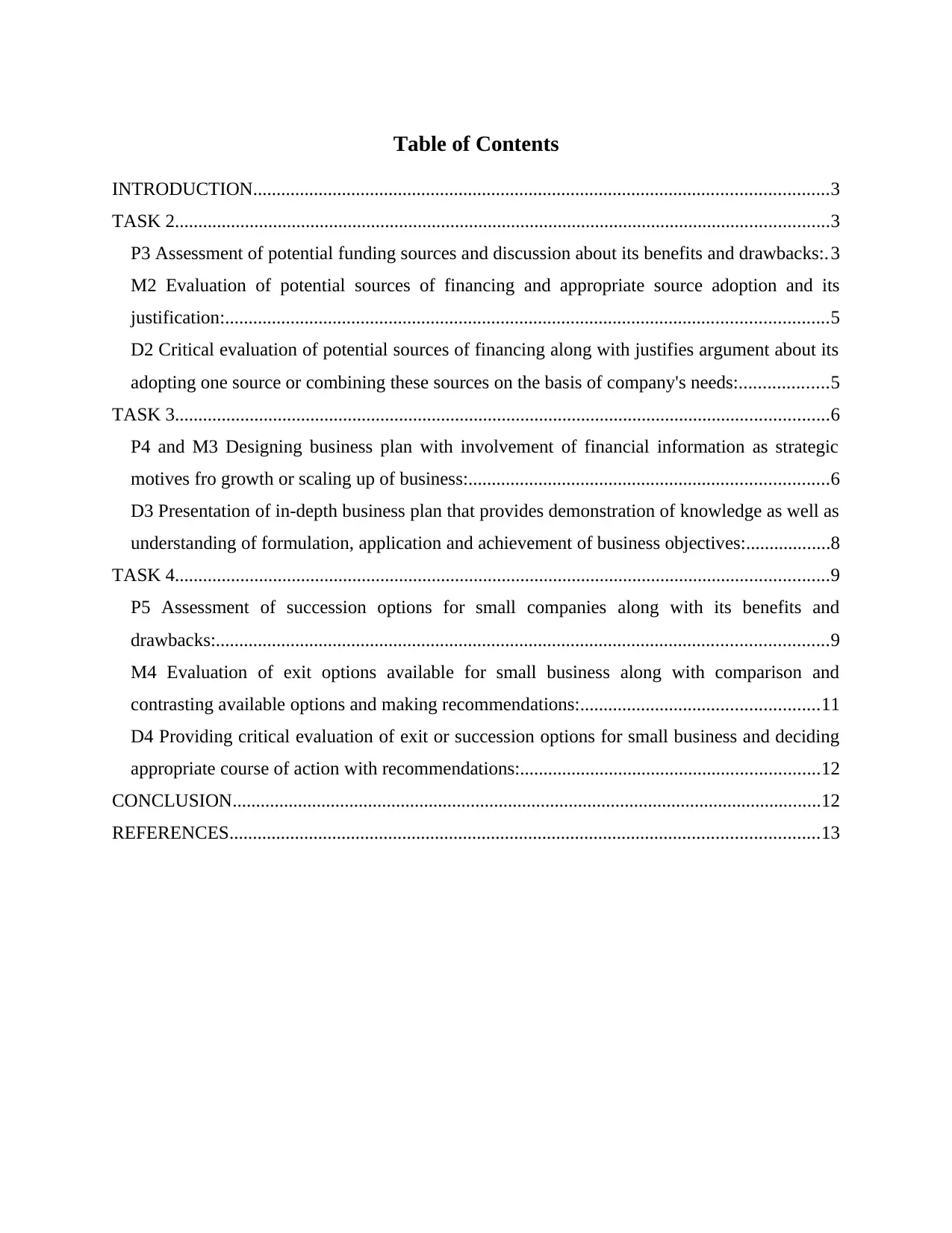
Table of Contents
INTRODUCTION...........................................................................................................................3
TASK 2............................................................................................................................................3
P3 Assessment of potential funding sources and discussion about its benefits and drawbacks:.3
M2 Evaluation of potential sources of financing and appropriate source adoption and its
justification:.................................................................................................................................5
D2 Critical evaluation of potential sources of financing along with justifies argument about its
adopting one source or combining these sources on the basis of company's needs:...................5
TASK 3............................................................................................................................................6
P4 and M3 Designing business plan with involvement of financial information as strategic
motives fro growth or scaling up of business:.............................................................................6
D3 Presentation of in-depth business plan that provides demonstration of knowledge as well as
understanding of formulation, application and achievement of business objectives:..................8
TASK 4............................................................................................................................................9
P5 Assessment of succession options for small companies along with its benefits and
drawbacks:...................................................................................................................................9
M4 Evaluation of exit options available for small business along with comparison and
contrasting available options and making recommendations:...................................................11
D4 Providing critical evaluation of exit or succession options for small business and deciding
appropriate course of action with recommendations:................................................................12
CONCLUSION..............................................................................................................................12
REFERENCES..............................................................................................................................13
INTRODUCTION...........................................................................................................................3
TASK 2............................................................................................................................................3
P3 Assessment of potential funding sources and discussion about its benefits and drawbacks:.3
M2 Evaluation of potential sources of financing and appropriate source adoption and its
justification:.................................................................................................................................5
D2 Critical evaluation of potential sources of financing along with justifies argument about its
adopting one source or combining these sources on the basis of company's needs:...................5
TASK 3............................................................................................................................................6
P4 and M3 Designing business plan with involvement of financial information as strategic
motives fro growth or scaling up of business:.............................................................................6
D3 Presentation of in-depth business plan that provides demonstration of knowledge as well as
understanding of formulation, application and achievement of business objectives:..................8
TASK 4............................................................................................................................................9
P5 Assessment of succession options for small companies along with its benefits and
drawbacks:...................................................................................................................................9
M4 Evaluation of exit options available for small business along with comparison and
contrasting available options and making recommendations:...................................................11
D4 Providing critical evaluation of exit or succession options for small business and deciding
appropriate course of action with recommendations:................................................................12
CONCLUSION..............................................................................................................................12
REFERENCES..............................................................................................................................13
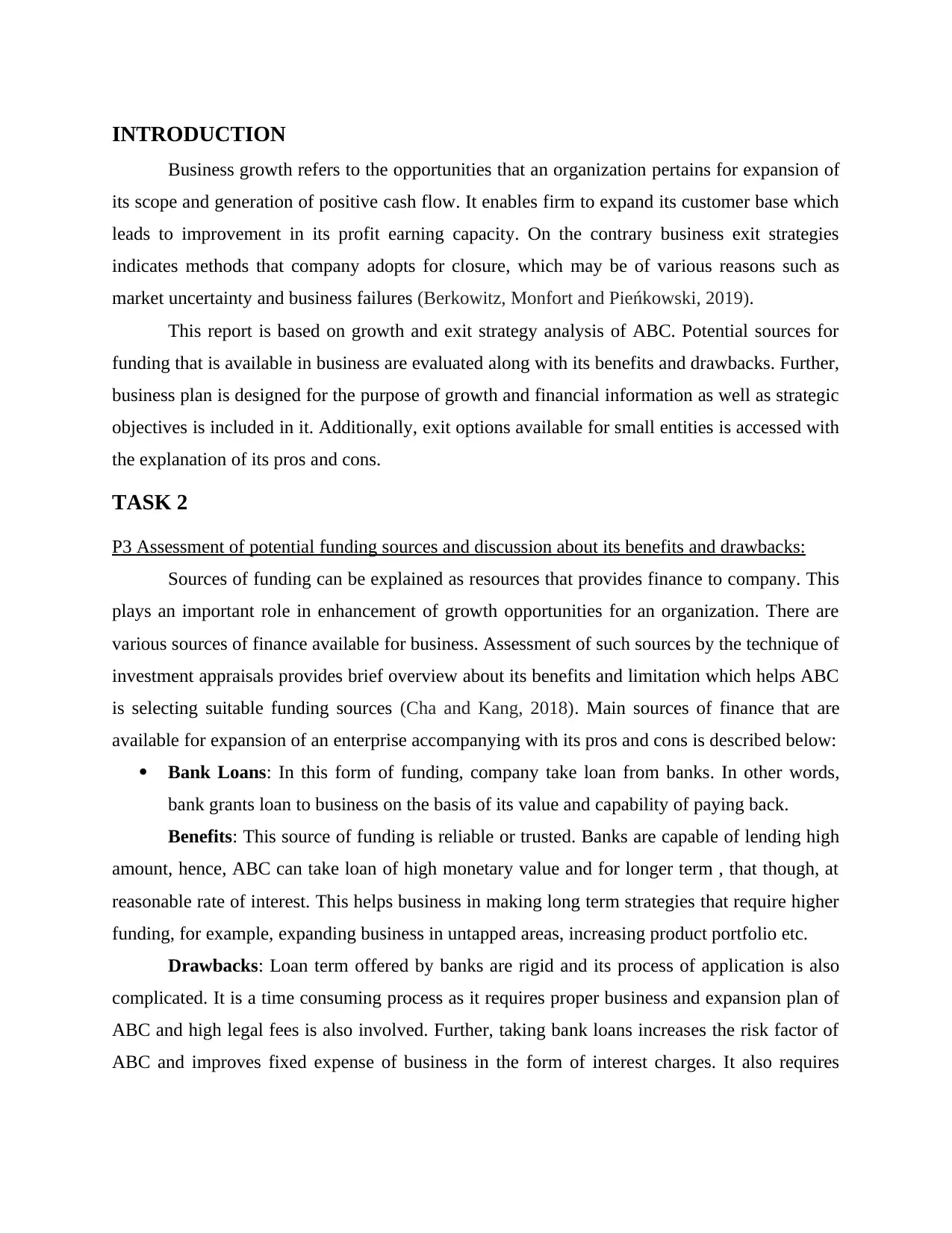
INTRODUCTION
Business growth refers to the opportunities that an organization pertains for expansion of
its scope and generation of positive cash flow. It enables firm to expand its customer base which
leads to improvement in its profit earning capacity. On the contrary business exit strategies
indicates methods that company adopts for closure, which may be of various reasons such as
market uncertainty and business failures (Berkowitz, Monfort and Pieńkowski, 2019).
This report is based on growth and exit strategy analysis of ABC. Potential sources for
funding that is available in business are evaluated along with its benefits and drawbacks. Further,
business plan is designed for the purpose of growth and financial information as well as strategic
objectives is included in it. Additionally, exit options available for small entities is accessed with
the explanation of its pros and cons.
TASK 2
P3 Assessment of potential funding sources and discussion about its benefits and drawbacks:
Sources of funding can be explained as resources that provides finance to company. This
plays an important role in enhancement of growth opportunities for an organization. There are
various sources of finance available for business. Assessment of such sources by the technique of
investment appraisals provides brief overview about its benefits and limitation which helps ABC
is selecting suitable funding sources (Cha and Kang, 2018). Main sources of finance that are
available for expansion of an enterprise accompanying with its pros and cons is described below:
Bank Loans: In this form of funding, company take loan from banks. In other words,
bank grants loan to business on the basis of its value and capability of paying back.
Benefits: This source of funding is reliable or trusted. Banks are capable of lending high
amount, hence, ABC can take loan of high monetary value and for longer term , that though, at
reasonable rate of interest. This helps business in making long term strategies that require higher
funding, for example, expanding business in untapped areas, increasing product portfolio etc.
Drawbacks: Loan term offered by banks are rigid and its process of application is also
complicated. It is a time consuming process as it requires proper business and expansion plan of
ABC and high legal fees is also involved. Further, taking bank loans increases the risk factor of
ABC and improves fixed expense of business in the form of interest charges. It also requires
Business growth refers to the opportunities that an organization pertains for expansion of
its scope and generation of positive cash flow. It enables firm to expand its customer base which
leads to improvement in its profit earning capacity. On the contrary business exit strategies
indicates methods that company adopts for closure, which may be of various reasons such as
market uncertainty and business failures (Berkowitz, Monfort and Pieńkowski, 2019).
This report is based on growth and exit strategy analysis of ABC. Potential sources for
funding that is available in business are evaluated along with its benefits and drawbacks. Further,
business plan is designed for the purpose of growth and financial information as well as strategic
objectives is included in it. Additionally, exit options available for small entities is accessed with
the explanation of its pros and cons.
TASK 2
P3 Assessment of potential funding sources and discussion about its benefits and drawbacks:
Sources of funding can be explained as resources that provides finance to company. This
plays an important role in enhancement of growth opportunities for an organization. There are
various sources of finance available for business. Assessment of such sources by the technique of
investment appraisals provides brief overview about its benefits and limitation which helps ABC
is selecting suitable funding sources (Cha and Kang, 2018). Main sources of finance that are
available for expansion of an enterprise accompanying with its pros and cons is described below:
Bank Loans: In this form of funding, company take loan from banks. In other words,
bank grants loan to business on the basis of its value and capability of paying back.
Benefits: This source of funding is reliable or trusted. Banks are capable of lending high
amount, hence, ABC can take loan of high monetary value and for longer term , that though, at
reasonable rate of interest. This helps business in making long term strategies that require higher
funding, for example, expanding business in untapped areas, increasing product portfolio etc.
Drawbacks: Loan term offered by banks are rigid and its process of application is also
complicated. It is a time consuming process as it requires proper business and expansion plan of
ABC and high legal fees is also involved. Further, taking bank loans increases the risk factor of
ABC and improves fixed expense of business in the form of interest charges. It also requires
⊘ This is a preview!⊘
Do you want full access?
Subscribe today to unlock all pages.

Trusted by 1+ million students worldwide
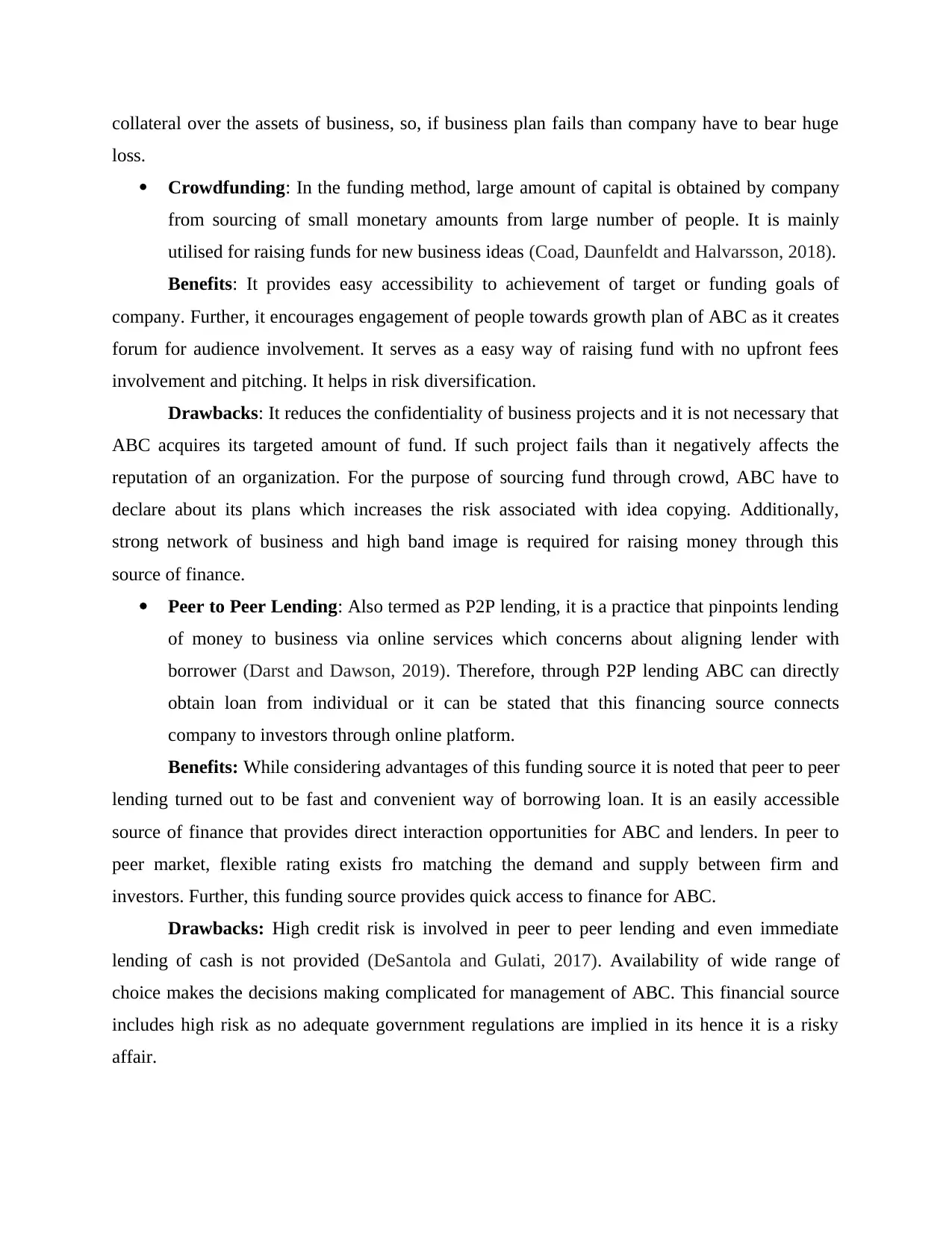
collateral over the assets of business, so, if business plan fails than company have to bear huge
loss.
Crowdfunding: In the funding method, large amount of capital is obtained by company
from sourcing of small monetary amounts from large number of people. It is mainly
utilised for raising funds for new business ideas (Coad, Daunfeldt and Halvarsson, 2018).
Benefits: It provides easy accessibility to achievement of target or funding goals of
company. Further, it encourages engagement of people towards growth plan of ABC as it creates
forum for audience involvement. It serves as a easy way of raising fund with no upfront fees
involvement and pitching. It helps in risk diversification.
Drawbacks: It reduces the confidentiality of business projects and it is not necessary that
ABC acquires its targeted amount of fund. If such project fails than it negatively affects the
reputation of an organization. For the purpose of sourcing fund through crowd, ABC have to
declare about its plans which increases the risk associated with idea copying. Additionally,
strong network of business and high band image is required for raising money through this
source of finance.
Peer to Peer Lending: Also termed as P2P lending, it is a practice that pinpoints lending
of money to business via online services which concerns about aligning lender with
borrower (Darst and Dawson, 2019). Therefore, through P2P lending ABC can directly
obtain loan from individual or it can be stated that this financing source connects
company to investors through online platform.
Benefits: While considering advantages of this funding source it is noted that peer to peer
lending turned out to be fast and convenient way of borrowing loan. It is an easily accessible
source of finance that provides direct interaction opportunities for ABC and lenders. In peer to
peer market, flexible rating exists fro matching the demand and supply between firm and
investors. Further, this funding source provides quick access to finance for ABC.
Drawbacks: High credit risk is involved in peer to peer lending and even immediate
lending of cash is not provided (DeSantola and Gulati, 2017). Availability of wide range of
choice makes the decisions making complicated for management of ABC. This financial source
includes high risk as no adequate government regulations are implied in its hence it is a risky
affair.
loss.
Crowdfunding: In the funding method, large amount of capital is obtained by company
from sourcing of small monetary amounts from large number of people. It is mainly
utilised for raising funds for new business ideas (Coad, Daunfeldt and Halvarsson, 2018).
Benefits: It provides easy accessibility to achievement of target or funding goals of
company. Further, it encourages engagement of people towards growth plan of ABC as it creates
forum for audience involvement. It serves as a easy way of raising fund with no upfront fees
involvement and pitching. It helps in risk diversification.
Drawbacks: It reduces the confidentiality of business projects and it is not necessary that
ABC acquires its targeted amount of fund. If such project fails than it negatively affects the
reputation of an organization. For the purpose of sourcing fund through crowd, ABC have to
declare about its plans which increases the risk associated with idea copying. Additionally,
strong network of business and high band image is required for raising money through this
source of finance.
Peer to Peer Lending: Also termed as P2P lending, it is a practice that pinpoints lending
of money to business via online services which concerns about aligning lender with
borrower (Darst and Dawson, 2019). Therefore, through P2P lending ABC can directly
obtain loan from individual or it can be stated that this financing source connects
company to investors through online platform.
Benefits: While considering advantages of this funding source it is noted that peer to peer
lending turned out to be fast and convenient way of borrowing loan. It is an easily accessible
source of finance that provides direct interaction opportunities for ABC and lenders. In peer to
peer market, flexible rating exists fro matching the demand and supply between firm and
investors. Further, this funding source provides quick access to finance for ABC.
Drawbacks: High credit risk is involved in peer to peer lending and even immediate
lending of cash is not provided (DeSantola and Gulati, 2017). Availability of wide range of
choice makes the decisions making complicated for management of ABC. This financial source
includes high risk as no adequate government regulations are implied in its hence it is a risky
affair.
Paraphrase This Document
Need a fresh take? Get an instant paraphrase of this document with our AI Paraphraser
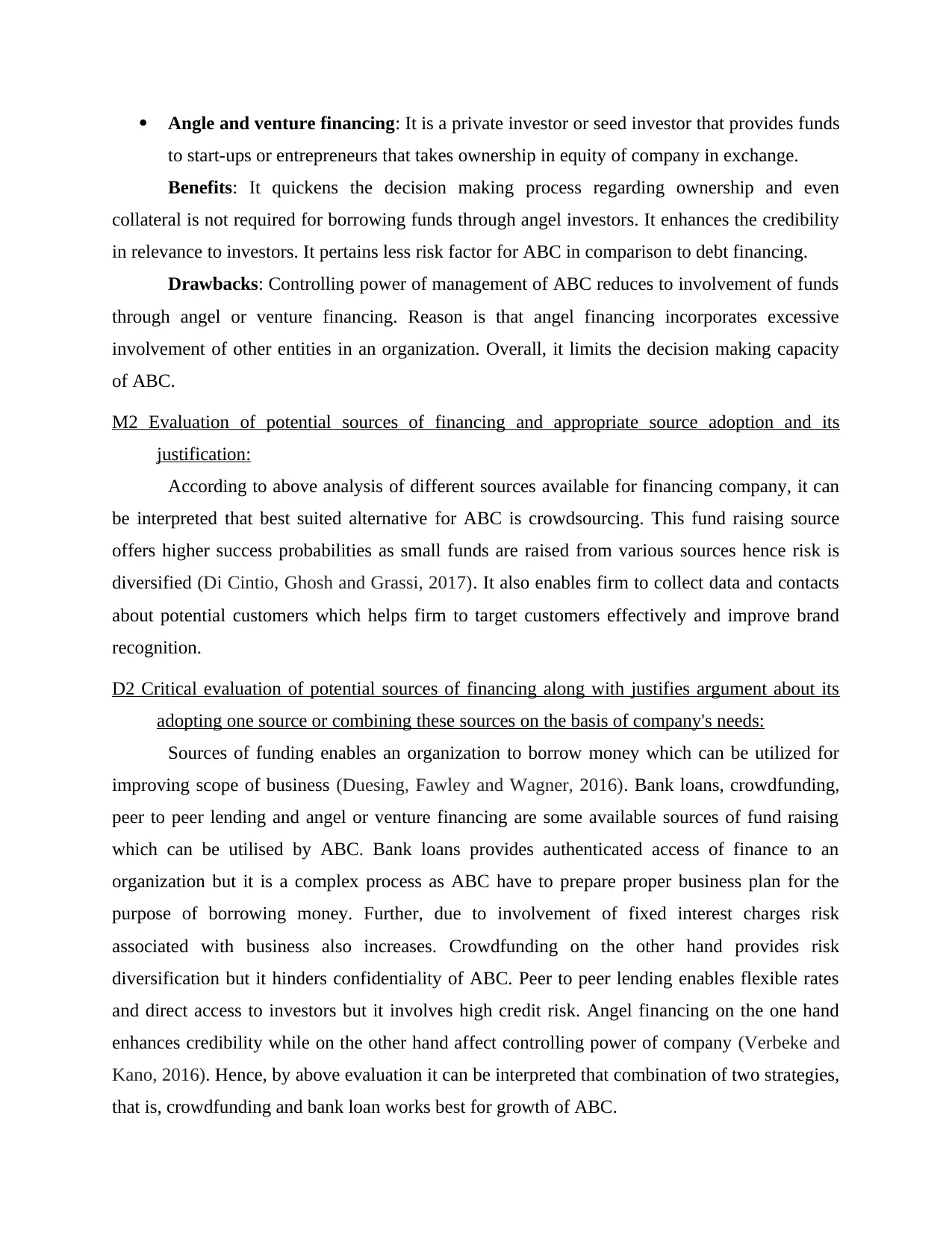
Angle and venture financing: It is a private investor or seed investor that provides funds
to start-ups or entrepreneurs that takes ownership in equity of company in exchange.
Benefits: It quickens the decision making process regarding ownership and even
collateral is not required for borrowing funds through angel investors. It enhances the credibility
in relevance to investors. It pertains less risk factor for ABC in comparison to debt financing.
Drawbacks: Controlling power of management of ABC reduces to involvement of funds
through angel or venture financing. Reason is that angel financing incorporates excessive
involvement of other entities in an organization. Overall, it limits the decision making capacity
of ABC.
M2 Evaluation of potential sources of financing and appropriate source adoption and its
justification:
According to above analysis of different sources available for financing company, it can
be interpreted that best suited alternative for ABC is crowdsourcing. This fund raising source
offers higher success probabilities as small funds are raised from various sources hence risk is
diversified (Di Cintio, Ghosh and Grassi, 2017). It also enables firm to collect data and contacts
about potential customers which helps firm to target customers effectively and improve brand
recognition.
D2 Critical evaluation of potential sources of financing along with justifies argument about its
adopting one source or combining these sources on the basis of company's needs:
Sources of funding enables an organization to borrow money which can be utilized for
improving scope of business (Duesing, Fawley and Wagner, 2016). Bank loans, crowdfunding,
peer to peer lending and angel or venture financing are some available sources of fund raising
which can be utilised by ABC. Bank loans provides authenticated access of finance to an
organization but it is a complex process as ABC have to prepare proper business plan for the
purpose of borrowing money. Further, due to involvement of fixed interest charges risk
associated with business also increases. Crowdfunding on the other hand provides risk
diversification but it hinders confidentiality of ABC. Peer to peer lending enables flexible rates
and direct access to investors but it involves high credit risk. Angel financing on the one hand
enhances credibility while on the other hand affect controlling power of company (Verbeke and
Kano, 2016). Hence, by above evaluation it can be interpreted that combination of two strategies,
that is, crowdfunding and bank loan works best for growth of ABC.
to start-ups or entrepreneurs that takes ownership in equity of company in exchange.
Benefits: It quickens the decision making process regarding ownership and even
collateral is not required for borrowing funds through angel investors. It enhances the credibility
in relevance to investors. It pertains less risk factor for ABC in comparison to debt financing.
Drawbacks: Controlling power of management of ABC reduces to involvement of funds
through angel or venture financing. Reason is that angel financing incorporates excessive
involvement of other entities in an organization. Overall, it limits the decision making capacity
of ABC.
M2 Evaluation of potential sources of financing and appropriate source adoption and its
justification:
According to above analysis of different sources available for financing company, it can
be interpreted that best suited alternative for ABC is crowdsourcing. This fund raising source
offers higher success probabilities as small funds are raised from various sources hence risk is
diversified (Di Cintio, Ghosh and Grassi, 2017). It also enables firm to collect data and contacts
about potential customers which helps firm to target customers effectively and improve brand
recognition.
D2 Critical evaluation of potential sources of financing along with justifies argument about its
adopting one source or combining these sources on the basis of company's needs:
Sources of funding enables an organization to borrow money which can be utilized for
improving scope of business (Duesing, Fawley and Wagner, 2016). Bank loans, crowdfunding,
peer to peer lending and angel or venture financing are some available sources of fund raising
which can be utilised by ABC. Bank loans provides authenticated access of finance to an
organization but it is a complex process as ABC have to prepare proper business plan for the
purpose of borrowing money. Further, due to involvement of fixed interest charges risk
associated with business also increases. Crowdfunding on the other hand provides risk
diversification but it hinders confidentiality of ABC. Peer to peer lending enables flexible rates
and direct access to investors but it involves high credit risk. Angel financing on the one hand
enhances credibility while on the other hand affect controlling power of company (Verbeke and
Kano, 2016). Hence, by above evaluation it can be interpreted that combination of two strategies,
that is, crowdfunding and bank loan works best for growth of ABC.
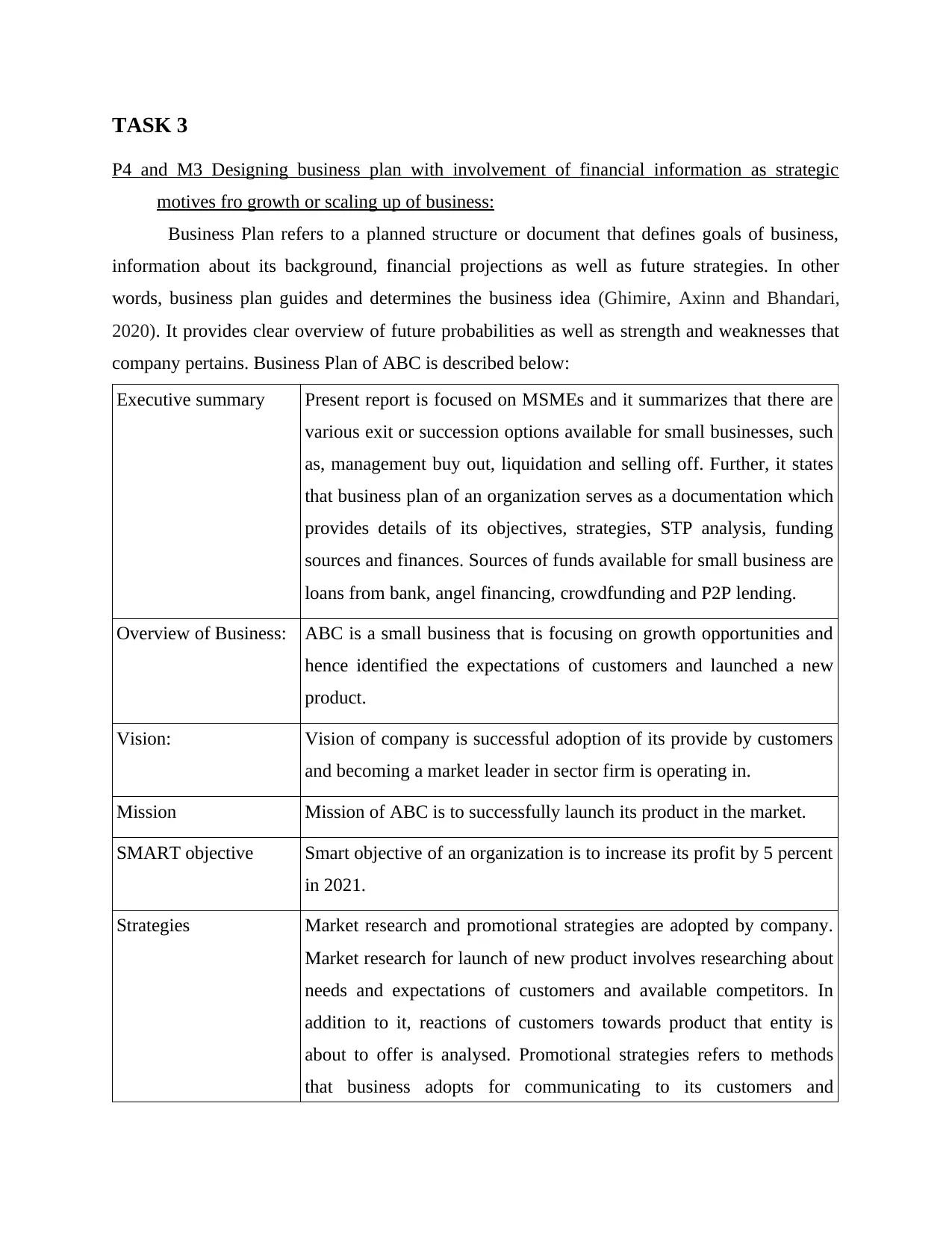
TASK 3
P4 and M3 Designing business plan with involvement of financial information as strategic
motives fro growth or scaling up of business:
Business Plan refers to a planned structure or document that defines goals of business,
information about its background, financial projections as well as future strategies. In other
words, business plan guides and determines the business idea (Ghimire, Axinn and Bhandari,
2020). It provides clear overview of future probabilities as well as strength and weaknesses that
company pertains. Business Plan of ABC is described below:
Executive summary Present report is focused on MSMEs and it summarizes that there are
various exit or succession options available for small businesses, such
as, management buy out, liquidation and selling off. Further, it states
that business plan of an organization serves as a documentation which
provides details of its objectives, strategies, STP analysis, funding
sources and finances. Sources of funds available for small business are
loans from bank, angel financing, crowdfunding and P2P lending.
Overview of Business: ABC is a small business that is focusing on growth opportunities and
hence identified the expectations of customers and launched a new
product.
Vision: Vision of company is successful adoption of its provide by customers
and becoming a market leader in sector firm is operating in.
Mission Mission of ABC is to successfully launch its product in the market.
SMART objective Smart objective of an organization is to increase its profit by 5 percent
in 2021.
Strategies Market research and promotional strategies are adopted by company.
Market research for launch of new product involves researching about
needs and expectations of customers and available competitors. In
addition to it, reactions of customers towards product that entity is
about to offer is analysed. Promotional strategies refers to methods
that business adopts for communicating to its customers and
P4 and M3 Designing business plan with involvement of financial information as strategic
motives fro growth or scaling up of business:
Business Plan refers to a planned structure or document that defines goals of business,
information about its background, financial projections as well as future strategies. In other
words, business plan guides and determines the business idea (Ghimire, Axinn and Bhandari,
2020). It provides clear overview of future probabilities as well as strength and weaknesses that
company pertains. Business Plan of ABC is described below:
Executive summary Present report is focused on MSMEs and it summarizes that there are
various exit or succession options available for small businesses, such
as, management buy out, liquidation and selling off. Further, it states
that business plan of an organization serves as a documentation which
provides details of its objectives, strategies, STP analysis, funding
sources and finances. Sources of funds available for small business are
loans from bank, angel financing, crowdfunding and P2P lending.
Overview of Business: ABC is a small business that is focusing on growth opportunities and
hence identified the expectations of customers and launched a new
product.
Vision: Vision of company is successful adoption of its provide by customers
and becoming a market leader in sector firm is operating in.
Mission Mission of ABC is to successfully launch its product in the market.
SMART objective Smart objective of an organization is to increase its profit by 5 percent
in 2021.
Strategies Market research and promotional strategies are adopted by company.
Market research for launch of new product involves researching about
needs and expectations of customers and available competitors. In
addition to it, reactions of customers towards product that entity is
about to offer is analysed. Promotional strategies refers to methods
that business adopts for communicating to its customers and
⊘ This is a preview!⊘
Do you want full access?
Subscribe today to unlock all pages.

Trusted by 1+ million students worldwide

influencing or attracting them for purchasing product that firm offers.
STP Segmentation: Demographic segmentation basis is adopted by ABC
for selecting its market segment. It indicates division of market on the
basis of age, family size, level of education, income level etc.
Targeting: target market for ABC is youngsters as their requirement
is product offering pinpoints alignment.
Positioning: Firm positions its product as high quality and affordable.
Sources of funds Crowdfunding and bank loans are two sources of funds that company
adopts. Former entitles arrangement of capital through small amounts
from various sources, while, later indicates borrowing of funds from
bank and paying interest charges on borrowed amount.
Financials Cash flow:
Cash Flow from
Operating
Activities
2020 2021 2022
Net Profit 165,500 182,050 200,255
Add
Depreciation
56,000 56,000 56,000
Total 221,500 238,050 256,255
Cash Flow from
Investing
Activities
Purchase of
Land - Building
560,000 - -
Purchase
Machinery,
Equipment
140,000 - 100,000
Total 700,000 - 100,000
STP Segmentation: Demographic segmentation basis is adopted by ABC
for selecting its market segment. It indicates division of market on the
basis of age, family size, level of education, income level etc.
Targeting: target market for ABC is youngsters as their requirement
is product offering pinpoints alignment.
Positioning: Firm positions its product as high quality and affordable.
Sources of funds Crowdfunding and bank loans are two sources of funds that company
adopts. Former entitles arrangement of capital through small amounts
from various sources, while, later indicates borrowing of funds from
bank and paying interest charges on borrowed amount.
Financials Cash flow:
Cash Flow from
Operating
Activities
2020 2021 2022
Net Profit 165,500 182,050 200,255
Add
Depreciation
56,000 56,000 56,000
Total 221,500 238,050 256,255
Cash Flow from
Investing
Activities
Purchase of
Land - Building
560,000 - -
Purchase
Machinery,
Equipment
140,000 - 100,000
Total 700,000 - 100,000
Paraphrase This Document
Need a fresh take? Get an instant paraphrase of this document with our AI Paraphraser

Cash Flow from
Financing
Activities
Long Term
Loan
280,000 - 100,000
Owner’s Equity 540,000 - 450,000
Total 820,000 - 350,000
Net Cash Flow 332,000 238,050 506,255
Add Cash at
Start
120,000 452,000 690,050
Total Cash at
End
452,000 690,050 1,196,305
Budget:
PARTICULAR
S
2020 2021 2022
Direct Cost
Stitching
1,886.7 2074.71 2282.181
Operating Cost
Cost
Administration
934.04 1027.44 1130.1884
Depreciation 56 56 56
Interest
Expense
9.2 10.12 11.132
Promotion 12 18 15
Market research 14 13 18
Salaries to staff 50 60 70
Financing
Activities
Long Term
Loan
280,000 - 100,000
Owner’s Equity 540,000 - 450,000
Total 820,000 - 350,000
Net Cash Flow 332,000 238,050 506,255
Add Cash at
Start
120,000 452,000 690,050
Total Cash at
End
452,000 690,050 1,196,305
Budget:
PARTICULAR
S
2020 2021 2022
Direct Cost
Stitching
1,886.7 2074.71 2282.181
Operating Cost
Cost
Administration
934.04 1027.44 1130.1884
Depreciation 56 56 56
Interest
Expense
9.2 10.12 11.132
Promotion 12 18 15
Market research 14 13 18
Salaries to staff 50 60 70
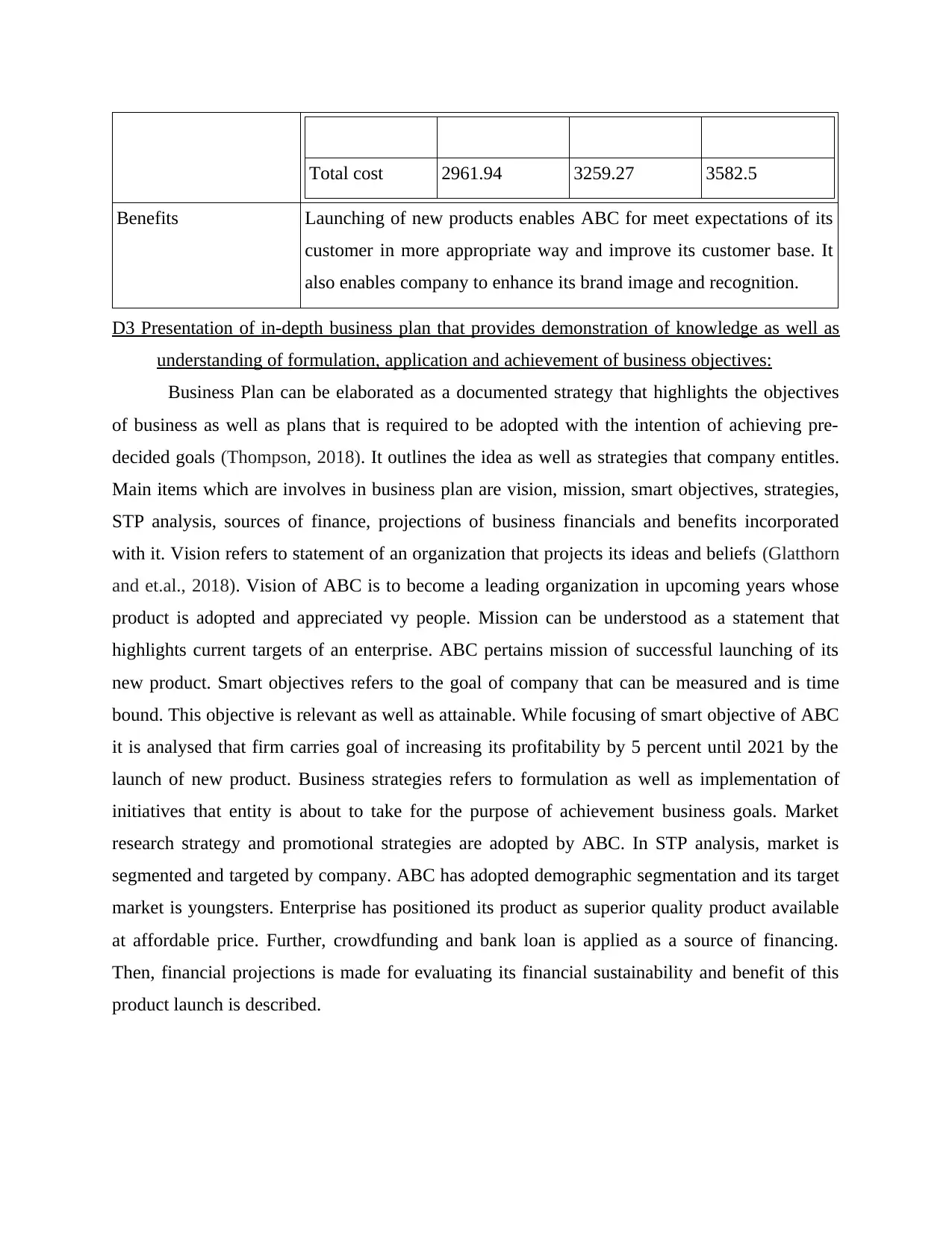
Total cost 2961.94 3259.27 3582.5
Benefits Launching of new products enables ABC for meet expectations of its
customer in more appropriate way and improve its customer base. It
also enables company to enhance its brand image and recognition.
D3 Presentation of in-depth business plan that provides demonstration of knowledge as well as
understanding of formulation, application and achievement of business objectives:
Business Plan can be elaborated as a documented strategy that highlights the objectives
of business as well as plans that is required to be adopted with the intention of achieving pre-
decided goals (Thompson, 2018). It outlines the idea as well as strategies that company entitles.
Main items which are involves in business plan are vision, mission, smart objectives, strategies,
STP analysis, sources of finance, projections of business financials and benefits incorporated
with it. Vision refers to statement of an organization that projects its ideas and beliefs (Glatthorn
and et.al., 2018). Vision of ABC is to become a leading organization in upcoming years whose
product is adopted and appreciated vy people. Mission can be understood as a statement that
highlights current targets of an enterprise. ABC pertains mission of successful launching of its
new product. Smart objectives refers to the goal of company that can be measured and is time
bound. This objective is relevant as well as attainable. While focusing of smart objective of ABC
it is analysed that firm carries goal of increasing its profitability by 5 percent until 2021 by the
launch of new product. Business strategies refers to formulation as well as implementation of
initiatives that entity is about to take for the purpose of achievement business goals. Market
research strategy and promotional strategies are adopted by ABC. In STP analysis, market is
segmented and targeted by company. ABC has adopted demographic segmentation and its target
market is youngsters. Enterprise has positioned its product as superior quality product available
at affordable price. Further, crowdfunding and bank loan is applied as a source of financing.
Then, financial projections is made for evaluating its financial sustainability and benefit of this
product launch is described.
Benefits Launching of new products enables ABC for meet expectations of its
customer in more appropriate way and improve its customer base. It
also enables company to enhance its brand image and recognition.
D3 Presentation of in-depth business plan that provides demonstration of knowledge as well as
understanding of formulation, application and achievement of business objectives:
Business Plan can be elaborated as a documented strategy that highlights the objectives
of business as well as plans that is required to be adopted with the intention of achieving pre-
decided goals (Thompson, 2018). It outlines the idea as well as strategies that company entitles.
Main items which are involves in business plan are vision, mission, smart objectives, strategies,
STP analysis, sources of finance, projections of business financials and benefits incorporated
with it. Vision refers to statement of an organization that projects its ideas and beliefs (Glatthorn
and et.al., 2018). Vision of ABC is to become a leading organization in upcoming years whose
product is adopted and appreciated vy people. Mission can be understood as a statement that
highlights current targets of an enterprise. ABC pertains mission of successful launching of its
new product. Smart objectives refers to the goal of company that can be measured and is time
bound. This objective is relevant as well as attainable. While focusing of smart objective of ABC
it is analysed that firm carries goal of increasing its profitability by 5 percent until 2021 by the
launch of new product. Business strategies refers to formulation as well as implementation of
initiatives that entity is about to take for the purpose of achievement business goals. Market
research strategy and promotional strategies are adopted by ABC. In STP analysis, market is
segmented and targeted by company. ABC has adopted demographic segmentation and its target
market is youngsters. Enterprise has positioned its product as superior quality product available
at affordable price. Further, crowdfunding and bank loan is applied as a source of financing.
Then, financial projections is made for evaluating its financial sustainability and benefit of this
product launch is described.
⊘ This is a preview!⊘
Do you want full access?
Subscribe today to unlock all pages.

Trusted by 1+ million students worldwide
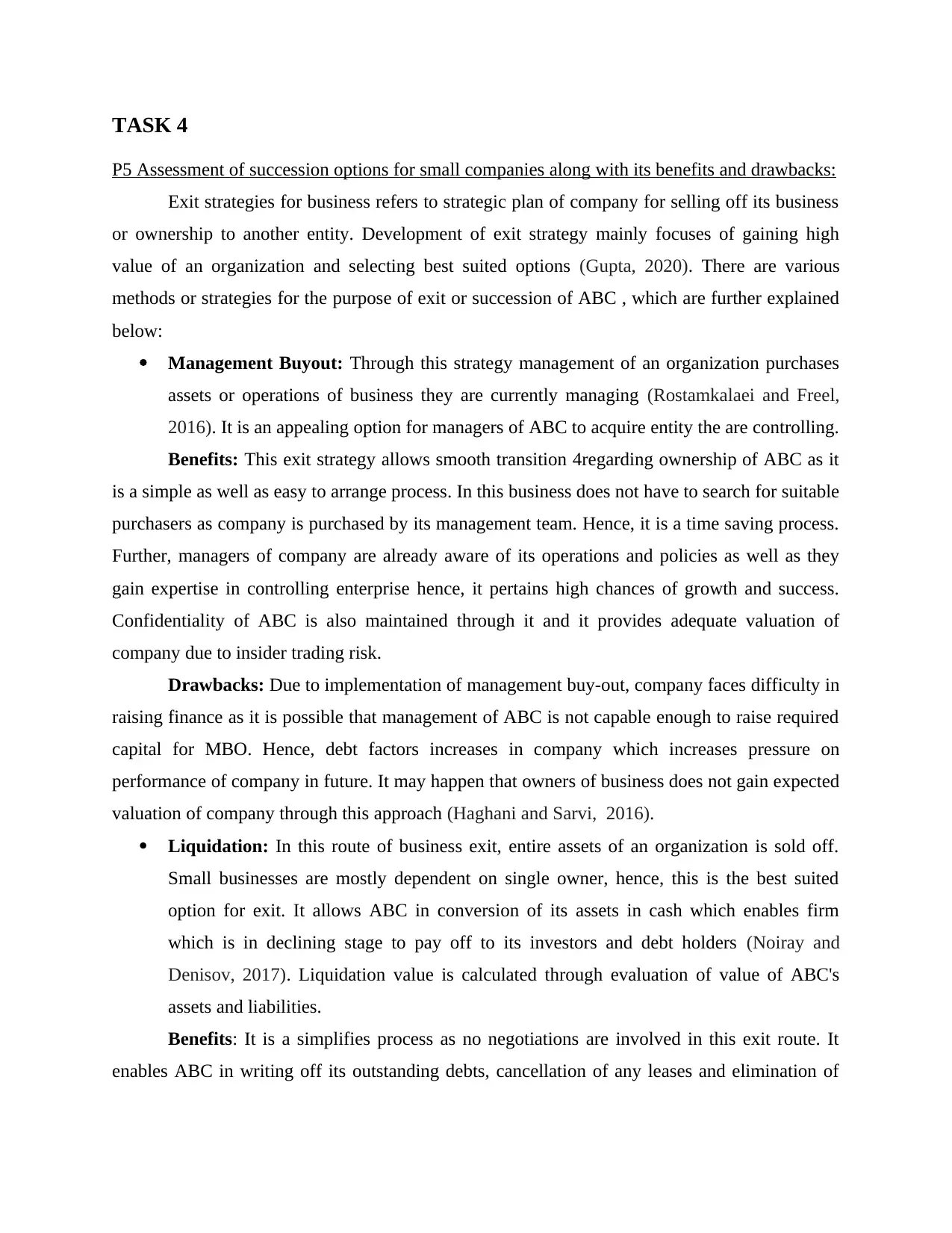
TASK 4
P5 Assessment of succession options for small companies along with its benefits and drawbacks:
Exit strategies for business refers to strategic plan of company for selling off its business
or ownership to another entity. Development of exit strategy mainly focuses of gaining high
value of an organization and selecting best suited options (Gupta, 2020). There are various
methods or strategies for the purpose of exit or succession of ABC , which are further explained
below:
Management Buyout: Through this strategy management of an organization purchases
assets or operations of business they are currently managing (Rostamkalaei and Freel,
2016). It is an appealing option for managers of ABC to acquire entity the are controlling.
Benefits: This exit strategy allows smooth transition 4regarding ownership of ABC as it
is a simple as well as easy to arrange process. In this business does not have to search for suitable
purchasers as company is purchased by its management team. Hence, it is a time saving process.
Further, managers of company are already aware of its operations and policies as well as they
gain expertise in controlling enterprise hence, it pertains high chances of growth and success.
Confidentiality of ABC is also maintained through it and it provides adequate valuation of
company due to insider trading risk.
Drawbacks: Due to implementation of management buy-out, company faces difficulty in
raising finance as it is possible that management of ABC is not capable enough to raise required
capital for MBO. Hence, debt factors increases in company which increases pressure on
performance of company in future. It may happen that owners of business does not gain expected
valuation of company through this approach (Haghani and Sarvi, 2016).
Liquidation: In this route of business exit, entire assets of an organization is sold off.
Small businesses are mostly dependent on single owner, hence, this is the best suited
option for exit. It allows ABC in conversion of its assets in cash which enables firm
which is in declining stage to pay off to its investors and debt holders (Noiray and
Denisov, 2017). Liquidation value is calculated through evaluation of value of ABC's
assets and liabilities.
Benefits: It is a simplifies process as no negotiations are involved in this exit route. It
enables ABC in writing off its outstanding debts, cancellation of any leases and elimination of
P5 Assessment of succession options for small companies along with its benefits and drawbacks:
Exit strategies for business refers to strategic plan of company for selling off its business
or ownership to another entity. Development of exit strategy mainly focuses of gaining high
value of an organization and selecting best suited options (Gupta, 2020). There are various
methods or strategies for the purpose of exit or succession of ABC , which are further explained
below:
Management Buyout: Through this strategy management of an organization purchases
assets or operations of business they are currently managing (Rostamkalaei and Freel,
2016). It is an appealing option for managers of ABC to acquire entity the are controlling.
Benefits: This exit strategy allows smooth transition 4regarding ownership of ABC as it
is a simple as well as easy to arrange process. In this business does not have to search for suitable
purchasers as company is purchased by its management team. Hence, it is a time saving process.
Further, managers of company are already aware of its operations and policies as well as they
gain expertise in controlling enterprise hence, it pertains high chances of growth and success.
Confidentiality of ABC is also maintained through it and it provides adequate valuation of
company due to insider trading risk.
Drawbacks: Due to implementation of management buy-out, company faces difficulty in
raising finance as it is possible that management of ABC is not capable enough to raise required
capital for MBO. Hence, debt factors increases in company which increases pressure on
performance of company in future. It may happen that owners of business does not gain expected
valuation of company through this approach (Haghani and Sarvi, 2016).
Liquidation: In this route of business exit, entire assets of an organization is sold off.
Small businesses are mostly dependent on single owner, hence, this is the best suited
option for exit. It allows ABC in conversion of its assets in cash which enables firm
which is in declining stage to pay off to its investors and debt holders (Noiray and
Denisov, 2017). Liquidation value is calculated through evaluation of value of ABC's
assets and liabilities.
Benefits: It is a simplifies process as no negotiations are involved in this exit route. It
enables ABC in writing off its outstanding debts, cancellation of any leases and elimination of
Paraphrase This Document
Need a fresh take? Get an instant paraphrase of this document with our AI Paraphraser
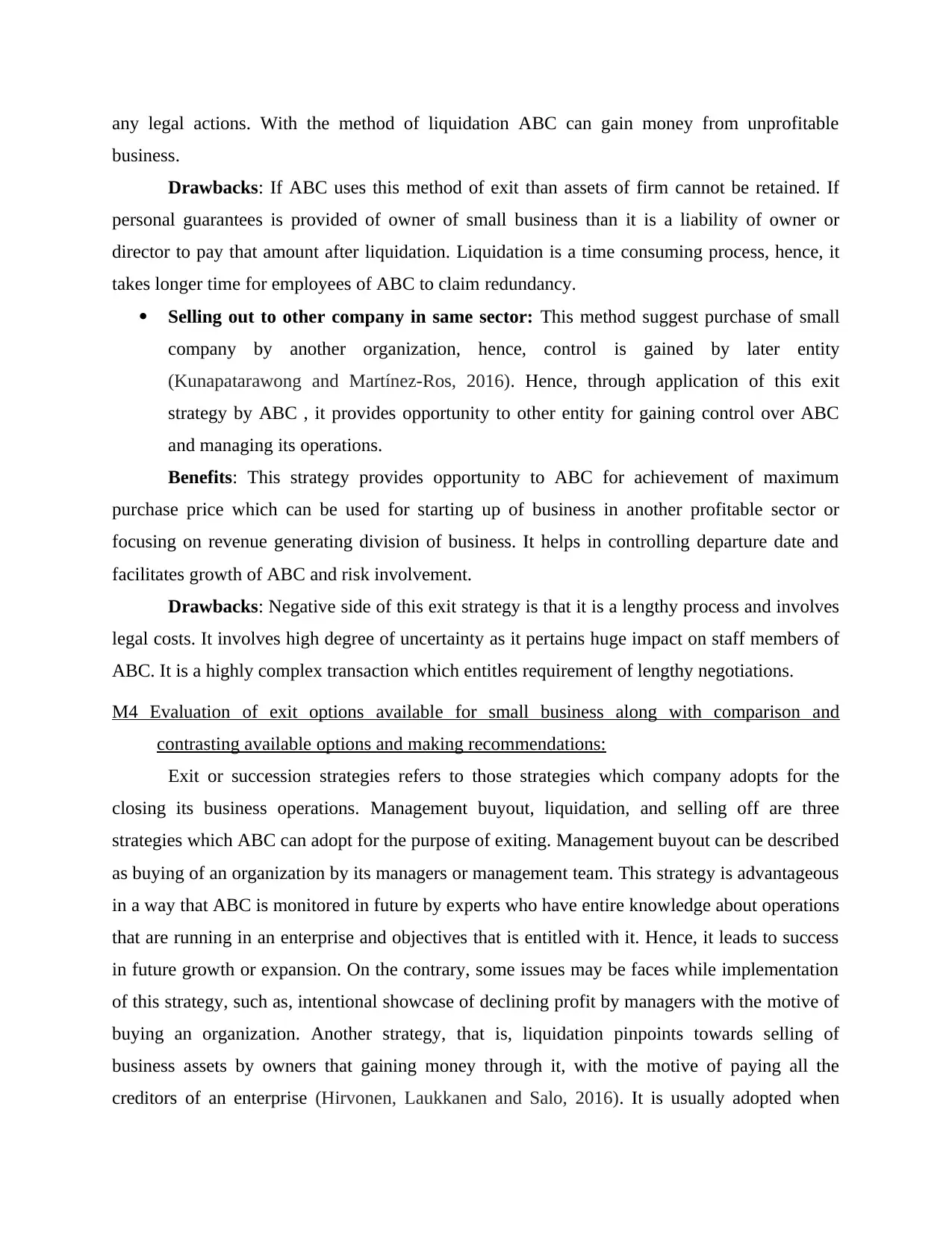
any legal actions. With the method of liquidation ABC can gain money from unprofitable
business.
Drawbacks: If ABC uses this method of exit than assets of firm cannot be retained. If
personal guarantees is provided of owner of small business than it is a liability of owner or
director to pay that amount after liquidation. Liquidation is a time consuming process, hence, it
takes longer time for employees of ABC to claim redundancy.
Selling out to other company in same sector: This method suggest purchase of small
company by another organization, hence, control is gained by later entity
(Kunapatarawong and Martínez-Ros, 2016). Hence, through application of this exit
strategy by ABC , it provides opportunity to other entity for gaining control over ABC
and managing its operations.
Benefits: This strategy provides opportunity to ABC for achievement of maximum
purchase price which can be used for starting up of business in another profitable sector or
focusing on revenue generating division of business. It helps in controlling departure date and
facilitates growth of ABC and risk involvement.
Drawbacks: Negative side of this exit strategy is that it is a lengthy process and involves
legal costs. It involves high degree of uncertainty as it pertains huge impact on staff members of
ABC. It is a highly complex transaction which entitles requirement of lengthy negotiations.
M4 Evaluation of exit options available for small business along with comparison and
contrasting available options and making recommendations:
Exit or succession strategies refers to those strategies which company adopts for the
closing its business operations. Management buyout, liquidation, and selling off are three
strategies which ABC can adopt for the purpose of exiting. Management buyout can be described
as buying of an organization by its managers or management team. This strategy is advantageous
in a way that ABC is monitored in future by experts who have entire knowledge about operations
that are running in an enterprise and objectives that is entitled with it. Hence, it leads to success
in future growth or expansion. On the contrary, some issues may be faces while implementation
of this strategy, such as, intentional showcase of declining profit by managers with the motive of
buying an organization. Another strategy, that is, liquidation pinpoints towards selling of
business assets by owners that gaining money through it, with the motive of paying all the
creditors of an enterprise (Hirvonen, Laukkanen and Salo, 2016). It is usually adopted when
business.
Drawbacks: If ABC uses this method of exit than assets of firm cannot be retained. If
personal guarantees is provided of owner of small business than it is a liability of owner or
director to pay that amount after liquidation. Liquidation is a time consuming process, hence, it
takes longer time for employees of ABC to claim redundancy.
Selling out to other company in same sector: This method suggest purchase of small
company by another organization, hence, control is gained by later entity
(Kunapatarawong and Martínez-Ros, 2016). Hence, through application of this exit
strategy by ABC , it provides opportunity to other entity for gaining control over ABC
and managing its operations.
Benefits: This strategy provides opportunity to ABC for achievement of maximum
purchase price which can be used for starting up of business in another profitable sector or
focusing on revenue generating division of business. It helps in controlling departure date and
facilitates growth of ABC and risk involvement.
Drawbacks: Negative side of this exit strategy is that it is a lengthy process and involves
legal costs. It involves high degree of uncertainty as it pertains huge impact on staff members of
ABC. It is a highly complex transaction which entitles requirement of lengthy negotiations.
M4 Evaluation of exit options available for small business along with comparison and
contrasting available options and making recommendations:
Exit or succession strategies refers to those strategies which company adopts for the
closing its business operations. Management buyout, liquidation, and selling off are three
strategies which ABC can adopt for the purpose of exiting. Management buyout can be described
as buying of an organization by its managers or management team. This strategy is advantageous
in a way that ABC is monitored in future by experts who have entire knowledge about operations
that are running in an enterprise and objectives that is entitled with it. Hence, it leads to success
in future growth or expansion. On the contrary, some issues may be faces while implementation
of this strategy, such as, intentional showcase of declining profit by managers with the motive of
buying an organization. Another strategy, that is, liquidation pinpoints towards selling of
business assets by owners that gaining money through it, with the motive of paying all the
creditors of an enterprise (Hirvonen, Laukkanen and Salo, 2016). It is usually adopted when
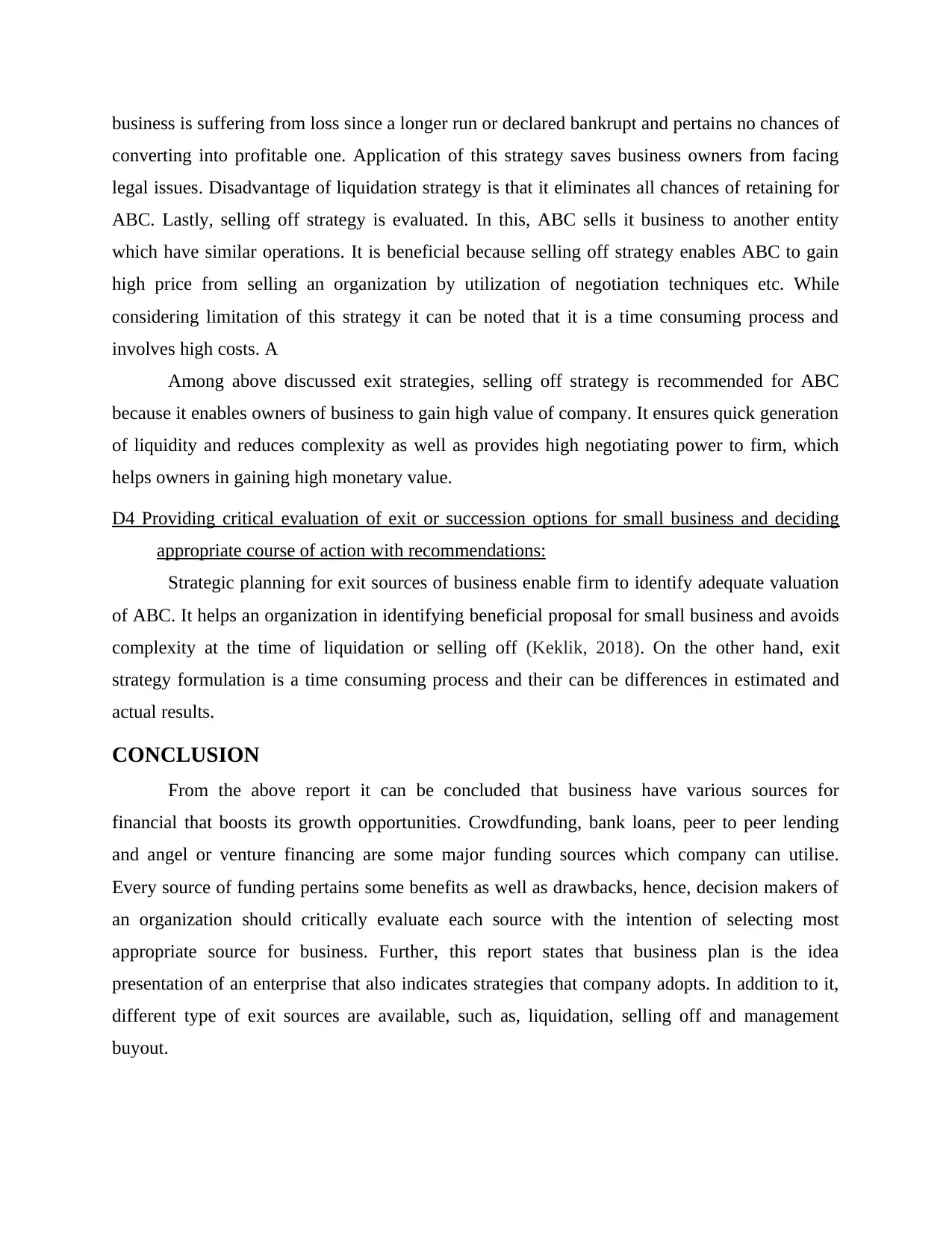
business is suffering from loss since a longer run or declared bankrupt and pertains no chances of
converting into profitable one. Application of this strategy saves business owners from facing
legal issues. Disadvantage of liquidation strategy is that it eliminates all chances of retaining for
ABC. Lastly, selling off strategy is evaluated. In this, ABC sells it business to another entity
which have similar operations. It is beneficial because selling off strategy enables ABC to gain
high price from selling an organization by utilization of negotiation techniques etc. While
considering limitation of this strategy it can be noted that it is a time consuming process and
involves high costs. A
Among above discussed exit strategies, selling off strategy is recommended for ABC
because it enables owners of business to gain high value of company. It ensures quick generation
of liquidity and reduces complexity as well as provides high negotiating power to firm, which
helps owners in gaining high monetary value.
D4 Providing critical evaluation of exit or succession options for small business and deciding
appropriate course of action with recommendations:
Strategic planning for exit sources of business enable firm to identify adequate valuation
of ABC. It helps an organization in identifying beneficial proposal for small business and avoids
complexity at the time of liquidation or selling off (Keklik, 2018). On the other hand, exit
strategy formulation is a time consuming process and their can be differences in estimated and
actual results.
CONCLUSION
From the above report it can be concluded that business have various sources for
financial that boosts its growth opportunities. Crowdfunding, bank loans, peer to peer lending
and angel or venture financing are some major funding sources which company can utilise.
Every source of funding pertains some benefits as well as drawbacks, hence, decision makers of
an organization should critically evaluate each source with the intention of selecting most
appropriate source for business. Further, this report states that business plan is the idea
presentation of an enterprise that also indicates strategies that company adopts. In addition to it,
different type of exit sources are available, such as, liquidation, selling off and management
buyout.
converting into profitable one. Application of this strategy saves business owners from facing
legal issues. Disadvantage of liquidation strategy is that it eliminates all chances of retaining for
ABC. Lastly, selling off strategy is evaluated. In this, ABC sells it business to another entity
which have similar operations. It is beneficial because selling off strategy enables ABC to gain
high price from selling an organization by utilization of negotiation techniques etc. While
considering limitation of this strategy it can be noted that it is a time consuming process and
involves high costs. A
Among above discussed exit strategies, selling off strategy is recommended for ABC
because it enables owners of business to gain high value of company. It ensures quick generation
of liquidity and reduces complexity as well as provides high negotiating power to firm, which
helps owners in gaining high monetary value.
D4 Providing critical evaluation of exit or succession options for small business and deciding
appropriate course of action with recommendations:
Strategic planning for exit sources of business enable firm to identify adequate valuation
of ABC. It helps an organization in identifying beneficial proposal for small business and avoids
complexity at the time of liquidation or selling off (Keklik, 2018). On the other hand, exit
strategy formulation is a time consuming process and their can be differences in estimated and
actual results.
CONCLUSION
From the above report it can be concluded that business have various sources for
financial that boosts its growth opportunities. Crowdfunding, bank loans, peer to peer lending
and angel or venture financing are some major funding sources which company can utilise.
Every source of funding pertains some benefits as well as drawbacks, hence, decision makers of
an organization should critically evaluate each source with the intention of selecting most
appropriate source for business. Further, this report states that business plan is the idea
presentation of an enterprise that also indicates strategies that company adopts. In addition to it,
different type of exit sources are available, such as, liquidation, selling off and management
buyout.
⊘ This is a preview!⊘
Do you want full access?
Subscribe today to unlock all pages.

Trusted by 1+ million students worldwide
1 out of 14
Related Documents
Your All-in-One AI-Powered Toolkit for Academic Success.
+13062052269
info@desklib.com
Available 24*7 on WhatsApp / Email
![[object Object]](/_next/static/media/star-bottom.7253800d.svg)
Unlock your academic potential
Copyright © 2020–2025 A2Z Services. All Rights Reserved. Developed and managed by ZUCOL.


